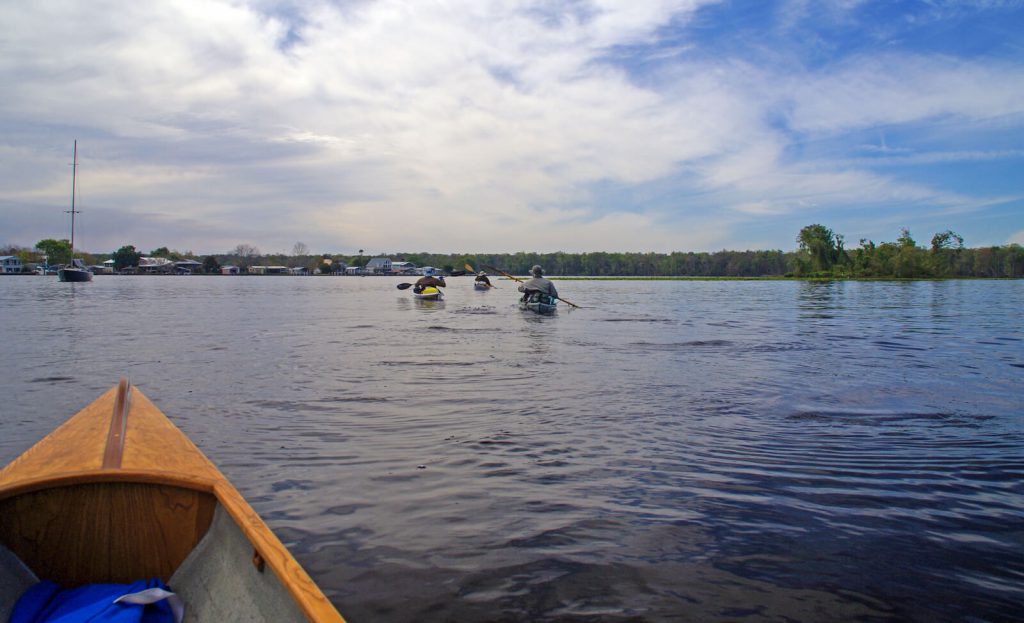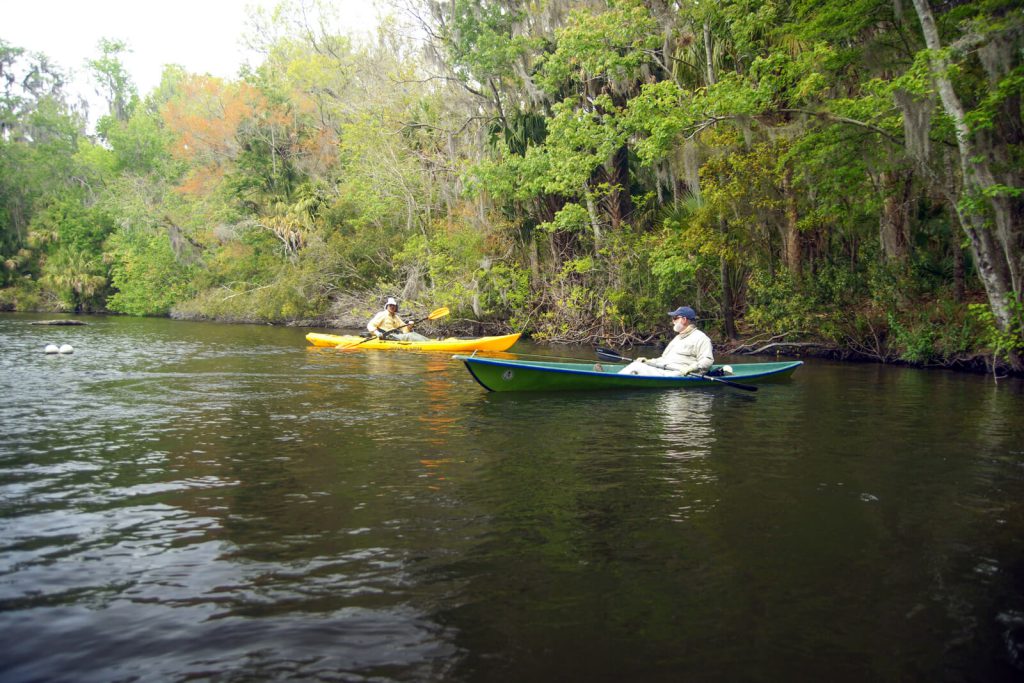17 Welaka Spring
Putnam County
it directly formed a large deep creek 40 or 50 yards wide to the river, and deep enough for a large boat to swim loaded to its head, which boils up near 8 foot deep from under the shelly rocks; ‘tis full of large fish, as cats, garr, mullets, and several other kinds, and plenty of alligators.
John and William Bartram
The Route
On December 27, 1765, John Bartram’s party broke camp at Spalding’s Lower Store, boarded their battoe and continued up river. After rowing an estimated five miles, they stopped beneath a tall bluff which John identified as Johnson’s Spring. They left their battoe and proceeded to hike as far south as Welaka Spring, crossing a number of lesser seeps and springs along the way. After reaching Welaka Spring, the Bartrams retraced their steps to retrieve their vessel and proceed back down river to “lodge” at Johnson’s Bluff; probably in close proximity to Welaka Spring (Figure 1).
It is apparent from their descriptions of the springs and seeps that their hike was along the shoreline probably in sight of the River (Figure 2). The topography in this area is characterized by a good deal of relief which afforded the group an interesting and challenging hike which is described in excellent detail in John’s Journal.
The Site
Springs are excellent landmarks and since their locations remain unchanged since the visit of the Bartrams, they afford those who desire to stand in the footprints of John and William the very best and very real opportunity to do so. While it can be a challenge to accurately identify the various springs mentioned in the Journal and match them to the known springs of today, the details provided in John Bartram’s description of the hike he and his group made on December 27, 1765 are sufficient to identify these sites with a good degree of confidence.
After leaving Nashua Spring, the group continued hiking south. The Journal describes the group traveling over hills and swamps for a total distance (from Johnson’s Spring) of 3 or 4 miles after which they discovered a “prodigious large fountain of clear water of loathsome taste.” The spring was in a cove nearly a quarter of a mile from the River and formed the head of a creek 40 or 50 yards wide and deep enough “for a large boat to swim loaded to its head.” This description, recorded two and a half centuries ago, paints a vivid picture of the setting of Welaka Spring even as it exists today. The Spring does indeed boil up from a depth of about 8 feet and is typically inhabited by a variety of fish and often visited by both alligators and manatee. The loathsome taste may be attributed to its sulfur content. Today, the flow from the Spring is far less than that observed by the Bartrams two and a half centuries ago. Groundwater withdrawals and misguided efforts to enlarge the rock-lined exit of the Spring’s cavern have reduced flow to a barely perceptible boil and that only visible during periods of low River stage. Even at normal stages, the dark River water often obscures the mouth of the Spring only a few feet below the surface.
Bartram Tail Site Marker 17 is located on the southeast shoreline of the Welaka Spring Run on the east side of the River in Welaka. It can only be reached by water and is surrounded by private property. It is located approximately 200 yards southwest of the main Spring vent (several smaller vents are dispersed along the run). Fortunately, the Spring is easily accessed via the deep and wide, quarter mile run from the River; just as Bartram observed (Figure 3). The most convenient access to the marker is either from Welaka’s Bryans Landing soft launch at the end Palmetto Street 1.84 miles south of the site (Figure 4) or from Putnam County’s Shell Harbor Public Boat Ramp 2.7 miles north of the site (Figure 5). The approach from the north (Shell Harbor Boat Ramp) affords the more sheltered paddle and passes two additional Bartram Trail Sites, however departing from Welaka affords the opportunity to view Welaka’s Bartram Kiosk located on Palmetto Street two blocks east of the River.
December 27, 1765 Journal Entry
“Thermometer 50, fine morning. Set out from the Store, and about 5 miles above, landed on a high bluff, on the east-side of the river, at Johnson’s Spring, a run of clear and sweet water, then travelled on foot along thick woody but loamy ground, looking rich on the surface by reason of the continual falling leaves, and by the constant evergreen shade rotting to soil, as the sun never shines on the ground strong enough to exhale their virtue before their dissolution, as under deciduous trees: We crossed several small rivulets of clear sweet water, and as many narrow moist swamps. ‘Tis diverting to observe the monstrous grape-vines, 8 inches in diameter, running up the oaks 6 foot in diameter, swamp-magnolia 70 foot high strait, and a foot diameter, the great magnolia very large, liquid-amber, white swamp and live oaks, chinquapines and cluster-cherry all of an uncommon size, mixed with orange-trees, either full of fruit or scattered on the ground, where the sun can hardly shine for the green leaves at Christmas, and all in a mass of white or yellow soil 16 foot more or less above the surface of the river. We came down a steep hill 20 foot high and about 4 or 500 yards from the river, under the foot of which issued out a large fountain (big enough to turn a mill) of warm clear water of a very offensive taste, and smelt like bilge-water, or the washings of a gun-barrel; the sediment that adhered to the trees fallen therein, looked of a pale white or bluish cast, like milk and water mixed: We then crossed the swamp, and ascended and descended two hills and narrow swamps more; at the foot of the last issued out another warm spring of clear water like the other, but not so large. Then travelling alternately over hills and swamps, in all about 3 or 4 miles, came to a great cove, near a quarter of a mile from the river, out of the head of which arose a prodigious large fountain of clear water of loathsome taste, like the other two before mentioned; it directly formed a large deep creek 40 or 50 yards wide to the river, and deep enough for a large boat to swim loaded to its head, which boils up near 8 foot deep from under the shelly rocks; ‘tis full of large fish, as cats, garr, mullets, and several other kinds, and plenty of alligators. Lodged at Johnson’s Bluff, where for a mile the sandy pine-barren comes close or near the shore, and here grew plenty of what is called wild limes, which shows that they will grow in poor soil though chiefly in rich.”
Resources and Links
The Journal
Florida History Online “John Bartram’s Travels on the St. Johns River, 1765-1766.” May 2013.
http://www.unf.edu/floridahistoryonline/Projects/Bartram.html
http://www.unf.edu/floridahistoryonline/Bartram/December_1765/27dec1765.htm
Bartram, John. Diary of a Journey through the Carolinas, Georgia, and Florida, from July 1, 1765, to April 10, 1766, annotated by Francis Harper. Transactions of the American Philosophical Society, n.s., Vol. XXXIII, Pt. I. Philadelphia, PA, 1942.
Additional References
Bruce, F.W. Assistant Engineer, US Army Corps of Engineers. St. Johns River to Lake Harney, Florida. 1908. The Portal to Texas History. University of North Texas. Nautical Chart of the St. Johns River.
http://texashistory.unt.edu/ark:/67531/metapth187523/m1/1/zoom/

